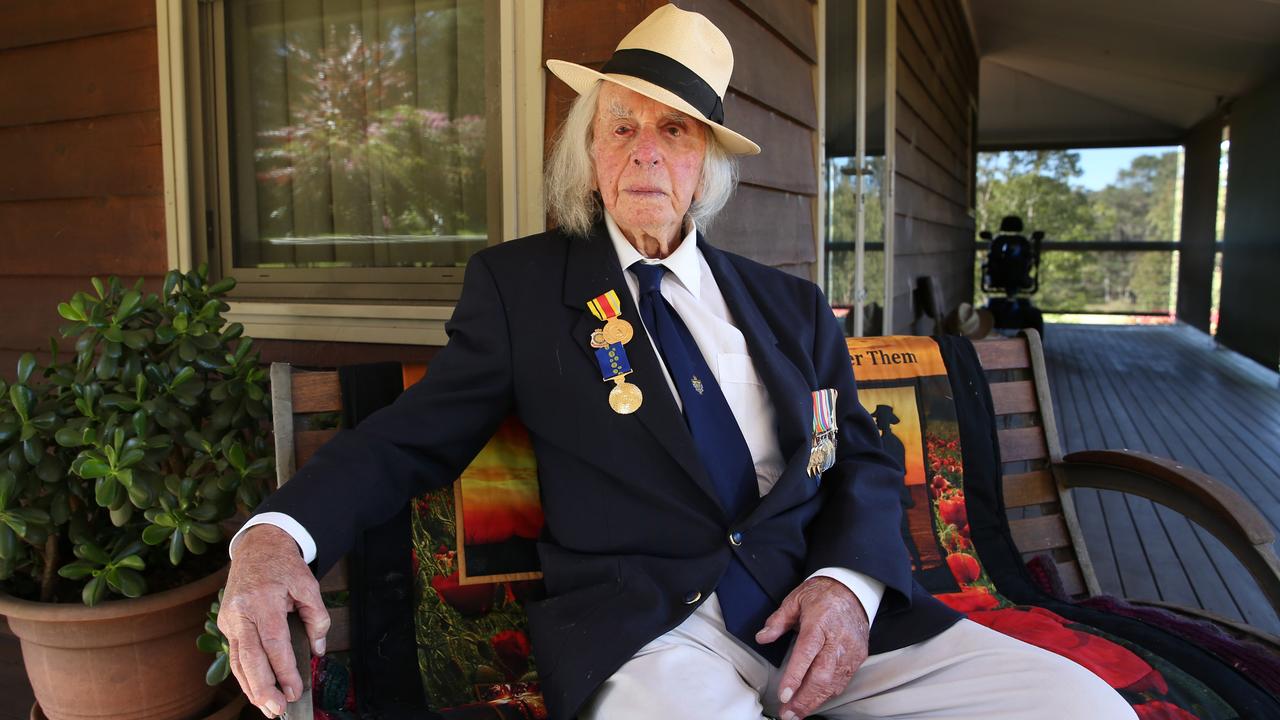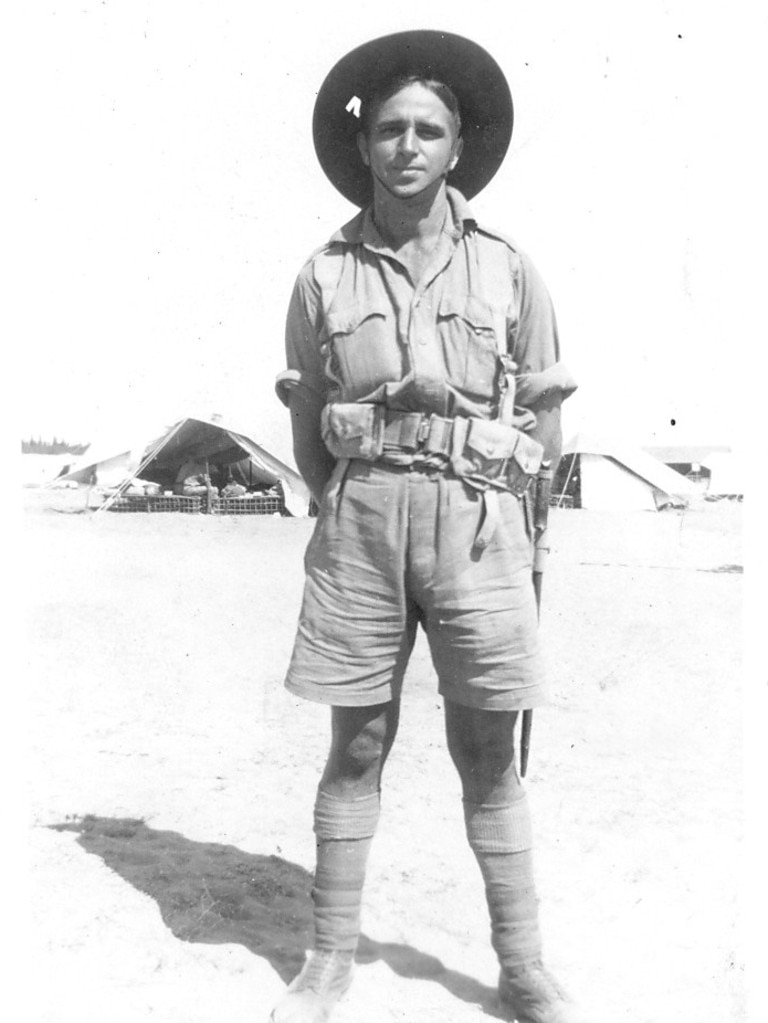Last NSW veteran of brutal 1941 Tobruk siege passes away at 106
The Last Post has played for Ernie Walker, who was the sole remaining NSW veteran of WWII’s famous siege of Libyan port town Tobruk and also survived the infamous Kokoda campaign

READING LEVEL: ORANGE
The last remaining “Rat of Tobruk*” from NSW, Ernie Walker has passed away at the incredible age of 106 years.
An Aussie hero of World War II, Mr Walker was farewelled on Thursday a week after he died peacefully at home with his wife by his side.

Only a handful of the original “Rats” are still alive today – and Mr Walker was the last of the Australian soldiers to survive the 1941 siege in the Libyan port to hail from NSW.
Five Dock RSL president Robert Ridge praised Mr Walker and said he would “always be remembered by those who knew him”.
“Ernie was a cherished* member of Five Dock RSL sub-branch, regarded as the spiritual home of the ‘Rats of Tobruk’,” Mr Ridge said.

The extraordinary efforts of mostly Australian soldiers across eight months, surviving daily bombings and tank attacks from German and Italian forces in the Tobruk garrison*, earned them the legendary reputation as the “Rats of Tobruk”.
German Field Marshal Erwin Rommel was unable to recapture the port due to the heroics of the Australian defenders.

They never surrendered or retreated, enduring “hellish dust storms”, searing* heat and living in dugouts, according to the Australian War Memorial.
“Their determination, bravery and humour, combined with the aggressive tactics of their commanders, became a source of inspiration during some of the war’s darkest days,” the memorial states in its official documents.

Mr Walker had spoken previously about his war experiences and said he still had memories from North Africa and the war.
“We were given the name the Rats (of Tobruk) by the German propagandist* Lord Haw Haw*,” he said last year.

“The name was meant to be a dig about us being trapped like rats and living in holes”, he said, but the Australians soon embraced it as a badge of honour, a title which exemplified* the courageous and resourceful* virtues* of the digger*.
Incredibly, Mr Walker also served in the notorious* Kokoda Trail campaign in Papua New Guinea, where more than 600 Australian soldiers died.
Rats of Tobruk Association secretary Lachlan Gaylard said Mr Walker was a true Australian larrikin*.

“Ernie is synonymous* with the Australian legend,” he said. “He was in Tobruk, on the Kokoda Trail, and his family tracks back to the First Fleet.
“He is literally an embodiment* of the Australian spirit. The original Tobruk medal that was made over there – Ernie had a part in the manufacturing of it.
“I don’t think even he understood the impact he had.

“What are the odds to live to the 80th anniversary of both of those campaigns – that is the amazing thing.
“Ernie was one of the older blokes, joining the war having being born in 1916, and there’s no way … it was expected he would be still here in 2022.”
Mr Walker’s local Penrose Community Association paid tribute to him in a post that said, “he was sharp as a tack until the end. What a life Ernie led.”
GLOSSARY
- Tobruk: a small port in northeast Libya on the Mediterranean coast
- cherished: cared for, loved and protected
- garrison: a military post where soldiers defend a town or building
- searing: extreme heat, scorching, blistering
- propagandist: someone who creates or spreads information intended to influence opinion
- Lord Haw Haw: William Joyce (1906–46), broadcaster of Nazi propaganda to Britain
- exemplified: was a typical example of something
- resourceful: able to find and use different ways to help achieve goals
- virtues: having good moral, ethical qualities
- digger: colloquial or slang name the Australian and New Zealand Army Corps (ANZAC) personnel developed in WWI and WWII
- notorious: famous or well-known for something bad
- larrikin: Aussie slang for a cheeky, mischievous man
- synonymous: two things so closely connected that one suggests the other
- embodiment: someone or something that precisely represents a quality or idea
EXTRA READING
Buried treasure seals WWII victory
Footy legend learns of his grandfather’s great escape
QUICK QUIZ
- What does the name “Rats of Tobruk” refer to?
- How long did the Australian soldiers spend defending the Tobruk garrison?
- According to the Australian War Memorial, what conditions did they endure?
- Who dubbed the Australian soldiers “Rats” in the first place?
- How many Australian soldiers died on the notorious Kokoda Trail during WWII?
LISTEN TO THIS STORY
CLASSROOM ACTIVITIES
1. Remember the Rats
Design or write a description of a special memorial for the Rats of Tobruk. Your memorial can be anything at all. The purpose of your memorial is to make sure that kids learn about and understand the story of the Rats and why we should remember and be inspired by them.
Time: allow 45 minutes to complete this activity
Curriculum Links: English; History
2. Extension
What year will it be when you turn 106? What do you think life will be like by then? Write a description of the things that you think will be different – and also things that you think might stay the same.
Time: allow 40 minutes to complete this activity
Curriculum Links: English; History
VCOP ACTIVITY
Imaginative dialogue
Imagine you were there during the event being discussed in the article, or for the interview.
Create a conversation between two characters from the article – you may need or want to include yourself as one of the characters. Don’t forget to try to use facts and details from the article to help make your dialogue as realistic as possible.
Go through your writing and highlight any punctuation you have used in green. Make sure you carefully check the punctuation used for the dialogue and ensure you have opened and closed the speaking in the correct places.

